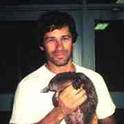
Swimming efficiencies of fish and cetaceans have been related to a certain synchrony between stroke cycle frequency, peak-to-peak tail/fluke amplitude and mean swimming speed. These kinematic parameters form a non-dimensional wake parameter, referred to as a Stroulial number, which for the range between 0.20 and 0.40 has been associated with enhanced swimming efficiency for fish and cetaceans. Yet to date there has been no direct experimental substantiation of what Strouhal numbers are preferred by swimming cetaceans. To address this lack of data, a total of 248 Stroubal numbers were calculated for the captive odontocete cetaceans Tursiops truncatus, Pseudorca crassidens, Orcinus orca, Globicephala melaena, Lagenorhynchus obliquidens and Stenella frontalis. Although the average Stroulial number calculated for each species is within the accepted range, considerable scatter is found in the data both within species and among individuals. A greater proportion of Strouhal values occur between 0.20 and 0.30 (74%) than the 0.25-0.35 (55%) range predicted for maximum swimming efficiency. Within 0.05 Stroulial increments, the greatest number of Strouhal values was found between 0.225 and 0.275 (44%). Where propulsive efficiency data were available (Tursiops truncatus, Pseudorca crassidens, Orcinus orca), peak swimming efficiency corresponded to this same Stroulial range. The odontocete cetacean data show that, besides being generally limited to a range of Strouhal numbers between 0.20 and 0.40, the kinematic parameters comprising the Stroulial number provide additional constraints. Fluke-beat frequency normalized by the ratio of swimming speed to body length was generally restricted from 1 to 2, whereas peak-to-peak fluke amplitude normalized by body length occurred predominantly between 0.15 and 0.25. The results indicate that the kinematics of the propulsive flukes of odontocete cetaceans are not solely dependent on Stroulial number, and the Stroubal number range for odontocete cetaceans; occurs at slightly (similar to20%) lower values than previously predicted for maximum swimming efficiency.
- strouhal number; swimming; dolphin; cetacean; odontocete; Tursiops; Pseudorca; Orcinus; Lagenorhynchus; Globicephala; Stenella delphinapterus
Available at: http://works.bepress.com/frank_fish/16/
